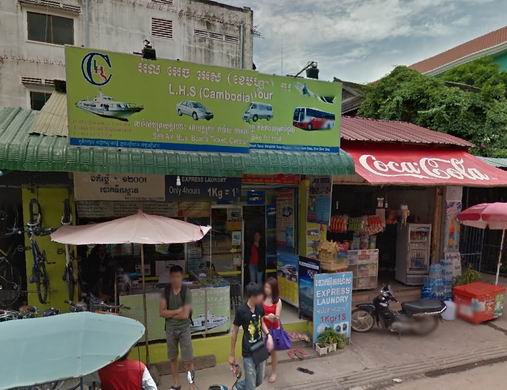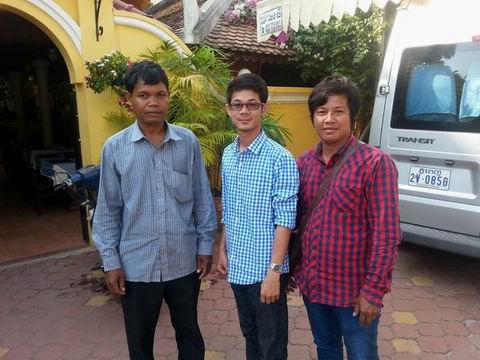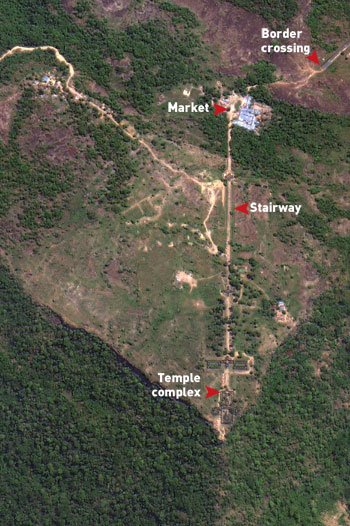This eleventh century temple is a prime example of a temple complex built in a line. Preah Vihear is a temple that is overloaded with superlatives: it stretches out for more more than 900 metres, the building blocks used are larger than in any other ttemple the Khmer ever built, the gopura's (pavillions) are of unique beauty, but, most of all, the location at which the complex is built is at least dramatic. The Dangrek mountain range forms the edge of the Korat plateau, which rises between 200 and 600 meters above sea level. Seen form the plains of Cambodia, which is flat like a pancake, this plateau rises like a wall of about 500 metres high - and on top of that stands the Preah Vihear temple complex.
The temple is built by kings Suryavarman I and Suryavarman II in a time of great prosperity of the Khmer empire. Access is from the north via land that is now part of Thailand (Sisaket province), but in the 11 th century it belonged to the Khmer empire.
The complex
After arriving at the top via an enormously steep road with many hairpin curves, a path with rock soil leads to the fiirst gopura (pavillion). From here, in northern direction, a monumental stairway leads to the actual entrance of the temple as well as to the small area surrounding the temple which includes the border crossing with Thailand.Back at the first gopura, in southern direction, the first access road with nagas appears. This road goes up and leads to the second gopura, after which the road continues to the transversal positioned third gopura. This gopura is very large, very beautiful and in fairly good condition. A next road leads to gopura 4, which contains the part that was damaged by a Thai army granate. It is impressive and attached to the final, central shrine at the end of the complex. Around this is a small strip of land and in fact the end of the cliff. From here, standing on the rocky soil, wind blowing through your hair, looking almost 500 meters down into Cambodia, the view is spectacular. Moreover, trying to resemble what the builders thought when they designed and built this, in their effort to ascend from the earth's surface, leave the earth behind and be closer to their gods. The Khmer king stood here with his priests, watching down like I did. It brings a bit of, what I call, historical sensation.
stairway, first access road with nagas, first gopura
--------------------------
road from first to second gopura, and pictures of the second gopura
----------------------------
second gopura seen from the third gopura, and more pictures of the very large third gopura
--------------------
fourth gopura, central shrine and views from the cliff
Visiting the temple
The word dramatic is also appplicable on my attempts to visit this temple. My first try was in October 2008, but the owner-dispute between Thailand and Cambodia had just broken out.
Second try was in 2011, I even rented a car for this purpose. After arriving in Sisaket, the situation at the border looked quiet and promising, but the next day, a local tourist office in Sisaket said the border was closed. They offered to call to the Thai military at the border town of Kantharalak so my friend, formerly active in the Thai army in this town, could speak to them. My understanding of the Thail language is good enought to know that this conversation would not have a positive outcome, and so it was. Did I travel for nothing? No, I had a plan B: exploring Khmer temples in Thailand. It proved to be a worthy alternative.
Third try was in March 2015, from the Cambodian side. Dear reader, you guessed it: it was succesfull! March 7 and 8 are days that I write with golden letters! To reach the temple, I booked a tour at a travel office in Siem Reap. L.H.S. Cambodia Tour, Taphul Village Area, Siem Reap, telephone +855 12 270 608. I requested a tour only to Preah Vihear, visiting on day 1, staying overnight in a hotel in Sra'em, visiting again on day 2 at sunrise, after that back to Siem Reap. Hotel, food, entrance and transport with a 4x4 ($25 return) not Included. I agreed the price of $ 165, paying $ 50 at the day of booking and the rest when we would be back. Car was a Toyota Highlander: large and comfortable. The driver spoke barely no English but drove quiet and without rush, the man who sold the tour to me went as a guide and translator. Travelling with two strange man to a very remote area? Yes, I was worried a little and frowned my eyebrows a few times. They turned out to be excellent company and delivered not only what was agreed, but also fine conversations, fun while having lunch and dinner, and a way of taking care of me that speaks of great hospitality. Thank you guys. Your office deserves to be mentioned!
 |
 |
------------------
Owner dispute between Thailand and Cambodia.
A lengthy and details description of this can be found at wikipedia, bur here I mention a few key moments. 1904: a first map was drawn between Siam and French IndoChina. In 1907, this map was reviewed between Siam and France. On the map, the temple lies in Cambodian territory. In 1954, Thai army occupied the temple and its surroundings after Cambodian independence from France in that same year. In 1962, the Cambodian government called for a decision of the International Court of Justice in The Hague; it ruled that the temple and its surroundings belong to Cambodia. Thailand experienced this decision as humiliating and never accepted it. In 2008, the Cambodian government succesfully applied to list the temple complex as a United Nations World Heritage site. This initially was backed by the Thai government, but strong nationalist groups, fueled by conservative, ultra-right, powerfull high-ranking figures protested heavily against their own government's stance. Result was a hot-hearted conflict with Cambodia leading to the deployment of armies, casualties (both military as well as civilians), a major damage to the temple (one wing blasted by Thai shelling) and much internationall interference. Cambodian soldiers are present at all times, watched by Thai army posts on the other side. I spoke to one of the soldiers via my Khmer guide; he said that if there is no military presence, the Thai army will come an occupy the temple again. When I asked him if he feared the Thai, he angrily called them the enemy. When I gave him two dollar so he could buy some cigarettes, or something special to eat, his eyes answered my question anyway.
| below:map showing the position of the temple on the sharp mountain point | below: a sign that says it all | |
 |
||
| below: one of the Thai army posts | below: the Cambodian soldier and I | |
back to Angkor page back to Cambodia page
further reading::
Sachchidanans Sahai, Preah Vihear, an introduction to the world heritage monument, Cambodian National Commission for Unesco, Buddhist Institute Printing House, ISBN 9789996303005 This book gives very detailed information about the temple, has interesting drawings, and some photo's.
http://en.wikipedia.org/wiki/Preah_Vihear_Temple - actual and in-depth information
http://preah-vihear.com/home/ - all about the current status of affairs between Thailand and Cambodia considering the temple